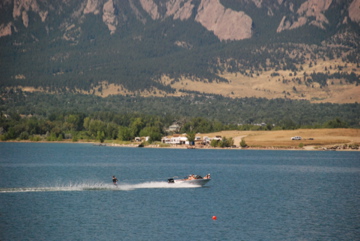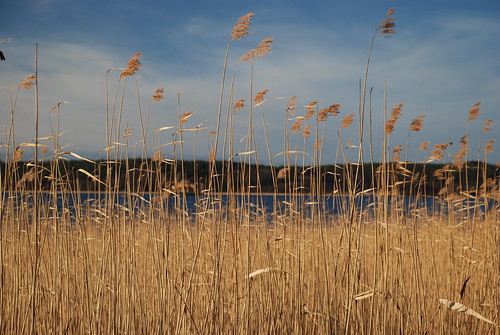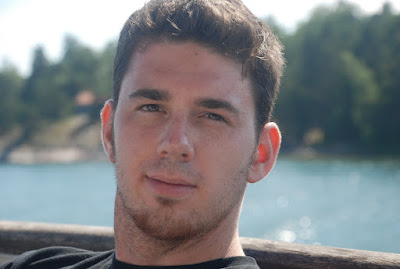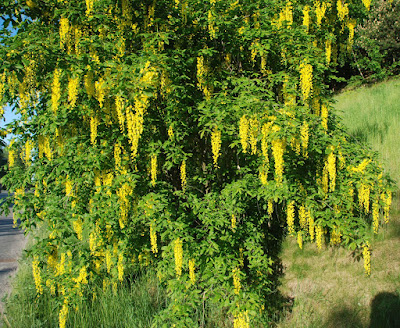
Last Thursday J and I went to the Zagreb, Croatia office. I had several business meetings (and is now dreaming up some more for the future). J got a few hours to walk around the center of Zagreb. Later that evening we got to experience a very fine Croatian meal which included some Croatian fig brandy, Croatian fish, Croatian squid salad, Croatian wine, and Croatian desserts. At 5:30 AM the next morning, one of my colleagues allowed us to ride with him on the four hour drive to Split, on the Dalmatian coast. Along the way we paused at a rest stop to look out over the canyon into the blue waters of the KrKa National Park. By the way, some of you haven't been waiting long enough for the images to load with maximum sharpness. These should be really nice images so if it's blurry, you have a slow connection and need to wait.
Later, he dropped us off at a hotel and came back later to pick me up for the meetings. After the meetings, we had a short guided tour of Diocletian's palace: he's the Roman emperor that killed a few Christians. In the beginning of his reign, he tolerated Christians but later decided not to keep them around. Read all about Diocletian on wikipedia.
Diocletian is also the first, if not the last, Roman emperor to voluntarily retire. He is also sometimes cited as the emperor that accelerated the demise of the empire by breaking it into four parts, so that there were four envious, suspicious, power hungry leaders. He was a Croatian and, therefore, thought it fitting to build his retirement home in Split, not far from where he grew up. It was a four star palace until he died and the Christians decided to vent some anger. They demolished all the statues and busts of Diocletian and completely ransacked his sarcophagus. They turned his chapel to the Roman god Jupiter into a baptismal room with Jupiter replaced with John the Baptist. They had other decorating ideas, too, but to avoid boring you too much I'll move on....

Split was just excellent (and cheap). Apparently lots of other tourists discovered that before me. In fact, I think if Croatia didn't have tourists, they'd be in dire straights. Check out my 50 or so Split pictures here.
We took a day trip to the island of Hvar. It's got some history behind it, too, which (don't click away yet), I won't bore you with. My pictures from the ferry ride from Split to Hvar are here. My photos on Hvar itself are here.
One thing you will not find in Croatia is an abundance of vowels. In fact, sometimes they just do without for the whole word. How about the Island of Krk? These folks would have been good programmers back in the long forgotten day when programmers had to use mnemonics of six characters or less. So we'd abbreviate "Next Value" with "NxtVal." Seems like Croatian to me.
Croatian is one of the Slavic languages. English is a Germanic language (and I always thought it was romantic! Uh, I mean a romance language.). Both languages are Indo-European.
Both Split and Hvar are on the Adriatic sea. The water is so clear you wouldn't believe it. Those tourist photos I used to suspect were photographically doctored are probably not.
We came to Croatia on a jet from Stockholm to Vienna and then took a small prop plane, a Fokker, to Zagreb. We left on a Fokker 100 from Split back to Vienna. I thought Fokker was long gone and Airbus and Boeing were the last two contestants. Guess not.
Descending down to Stockholm as the sun was low (as it is just about all day long) we saw the amazing number of islands and waterways. The water was granite grey, the island flush with green but dotted with the typical Swedish burnt red, custard yellow or white buildings. The green pastures were littered with the giant hay bails covered in the white plastic. The skies were blue with the white fluffy clouds. Contrast those colors with the colors in Croatia. Deep blue water with some greens mixed in, white rocks, white or grey buildings with the red Mediterranean tile roofs, and blue cloudless skies.
That's when I began to think how people correlate with the colors, or maybe it's the temperature. Hmmm. Guns, Germs, and Steel and Colors? I guess I have to factor in the Swedish winter's too where the colors change. In fact, most summer days have not had blue skies and white clouds: they had grey clouds and not much sun. No wonder Swedes worship the sun.
A few notes on the paint: The red paint so popular in Sweden uses a residue from copper mines, the most famous, which was in operation before the year 1000 is near Dalarna. This paint, although it tends to look old quickly is an excellent protector of wood. The wood can last hundreds of years in harsh weather with a fresh coat every 15 years. The yellow paint is sometimes associated with wealth because long ago the wealthy folks painted their palaces this color, I'm not sure why.





















































